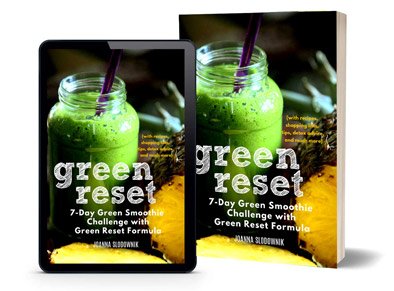I admit I have been kind of lazy in the past, rarely buying organic produce (I have to drive 5+ miles to the nearest Wholefoods to get organic greens), but shopping mostly at a local grocery store that sells conventionally grown instead.
So one day, I finally decided to really look into this issue a little deeper, starting with checking the pesticide content of the greens that I use for my smoothies.
The fruits and greens that I use in my green smoothies are fabulous foods, full of vital nutrients that are supposed help keep our bodies strong and immune to disease, right?
Well, sort of.
Many studies show that most conventionally farmed foods have pesticide and other chemical residues. Repeated tests show that many of these foods can literally carry “a cocktail of synthetic poisons.” A growing body of science is showing that repeated exposures, to cocktails of small amounts of synthetic chemicals, have a range of adverse health effects.
Of course, I knew that, but I decided to investigate exactly which foods are most contaminated, and make a list of foods that I need to buy organic at your farmer’s market or supermarket that carries organic produce.
Here is what I found out.
The average conventionally grown apple has 20 to 30 artificial chemicals on its skin, even after rinsing. If you’re eating non-organic celery today, you may be ingesting 67 pesticides with it, according to a report from the Environmental Working Group (EWG).
Many scientists believe these exposures, of minute quantities of agricultural chemicals, are very significant, especially for children.
The Environmental Working Group, a nonprofit focused on public health, scoured nearly 100,000 produce pesticide reports from the U.S. Department of Agriculture and the U.S. Food and Drug Administration to determine what fruits and vegetables we eat have the highest, and lowest, amounts of chemical residue.
Most alarming are the fruits and vegetables dubbed the “Dirty Dozen,” which contain 47 to 67 pesticides per serving. These foods are believed to be most susceptible because they have soft skin that tends to absorb more pesticides.
The Dirty Dozen – Buy Organic if possible
So here is the list of the so-called Dirty Dozen, the foods that are most contaminated, so we need to limit their consumption or only buy organic:
Celery
Peaches
Strawberries
Apples
Blueberries
Nectarines
Sweet bell peppers
Spinach, kale and collard greens
Cherries
Potatoes
Grapes (imported)
Lettuce
Other than bananas (that are not on this list) and potatoes (that are on this list buy we don’t eat them as often), this list contains most fruits and vegetables that I frequently use in my green smoothies and salads!
The Clean 15
Conventional Produce Lowest in Pesticides
Not all non-organic fruits and vegetables have a high pesticide level. Some produce has a strong outer layer that provides a defense against pesticide contamination. The group found a number of non-organic fruits and vegetables dubbed the “Clean 15” that contained little to no pesticides.
Onions
Avocados
Sweet corn
Pineapples
Mango
Sweet peas
Asparagus
Kiwi fruit
Cabbage
Eggplant
Cantaloupe
Watermelon
Grapefruit
Sweet potatoes
Sweet onions
Honeydew Melon
To limit your exposure, it makes sense to peel fruits, if possible, and not to eat skins, unless you are able to purchase those vegetables in organic form. Remove and discard the outermost leaves of lettuce and cabbage, and other surfaces that cannot be peeled can be washed with soap and water, or a commercial vegetable wash.
Some of my favorite foods and ingredients for my smoothies are on the dirty-dozen list. And even the “OK to eat produce” isn’t completely safe. At my house, we do consume lots of green smoothies, so, needless to say, I worry about the toxins level, especially when it comes to my son.
For example, a study out of Harvard shows that even tiny, allowable amounts of a common pesticide class can have dramatic effects on brain chemistry. Organophosphate insecticides (OP’s) are among the most widely used pesticides in the U.S. & have long been known to be particularly toxic for children. This is the first study to examine their effects across a representative population with average levels of exposure. Finding :: Kids with above-average pesticide exposures are 2x as likely to have ADHD. Read the full report
The chemicals sprayed on conventional food crops have been linked to numerous diseases, including birth defects, Parkinson’s, numerous cancers and diabetes.
Here is where you can check the pesticide residue on popular produce – go to http://www.whatsonmyfood.org/
I don’t know about you, but I find it appalling that eating these (and other) foods that we buy because they are healthy (and delicious) can make us sick!
Personally, I don’t want to worry about the dangerous toxins when I buy my fruits, vegetables and greens for juicing, blending or cooking.
Organic is not a luxury; it’s how food is supposed to be!
Buying organic and pesticide-free whenever possible makes sense and is an important start. But being a responsible consumer will not make enough of a difference to make our food system sustainable and safe for ourselves and future generations.
In the second installment of this article I’ll be writing about nutritional value of organic versus conventional produce.
Solutions are available, and decisions are being made now. I’ll also be writing about what we can all do to make organic foods more available and affordable.
Questions? Comments? Suggestions?
If you have a favorite recipe, why not submit it here in the comment section of this smoothie recipes blog for others to enjoy too!
I also welcome any comments, questions and suggestions. Thanks!


Does it help to rinse or soak fruits/veggies in a vinegar rinse? I do that expecially with apples; they usually have a waxed skin. Also if you are peeling apples, cucumbers and other things aren’t you losing nutrient/fiber content?